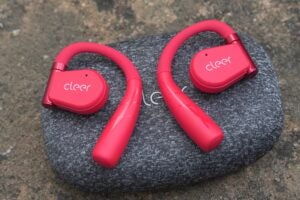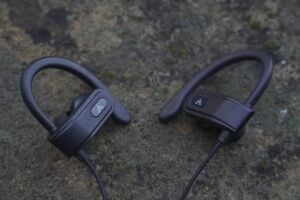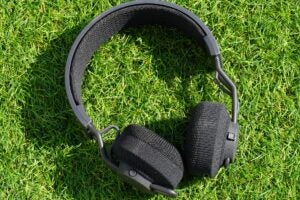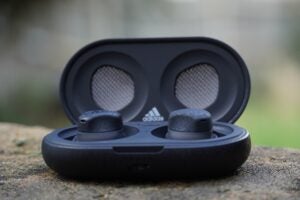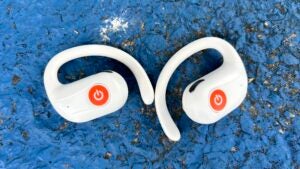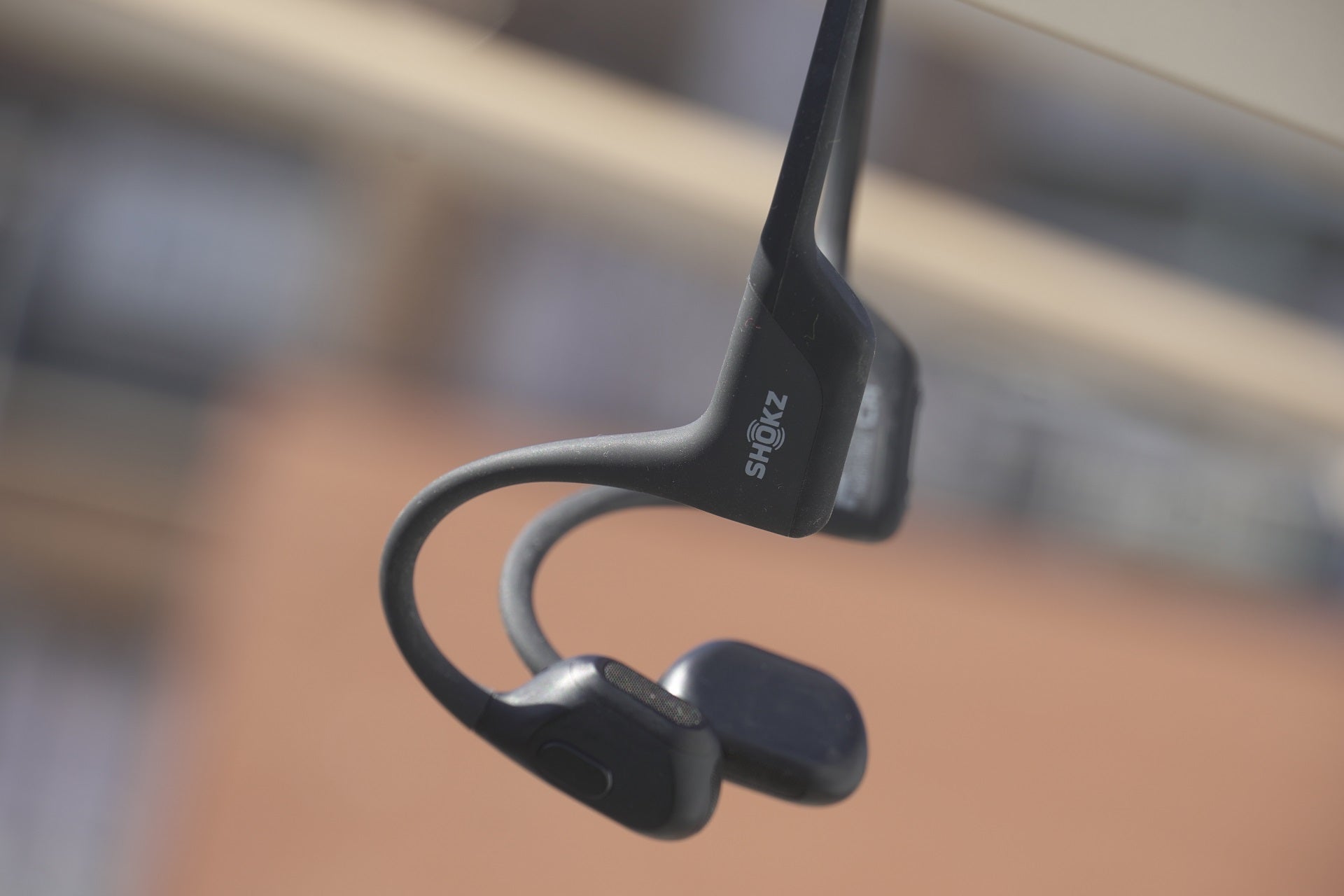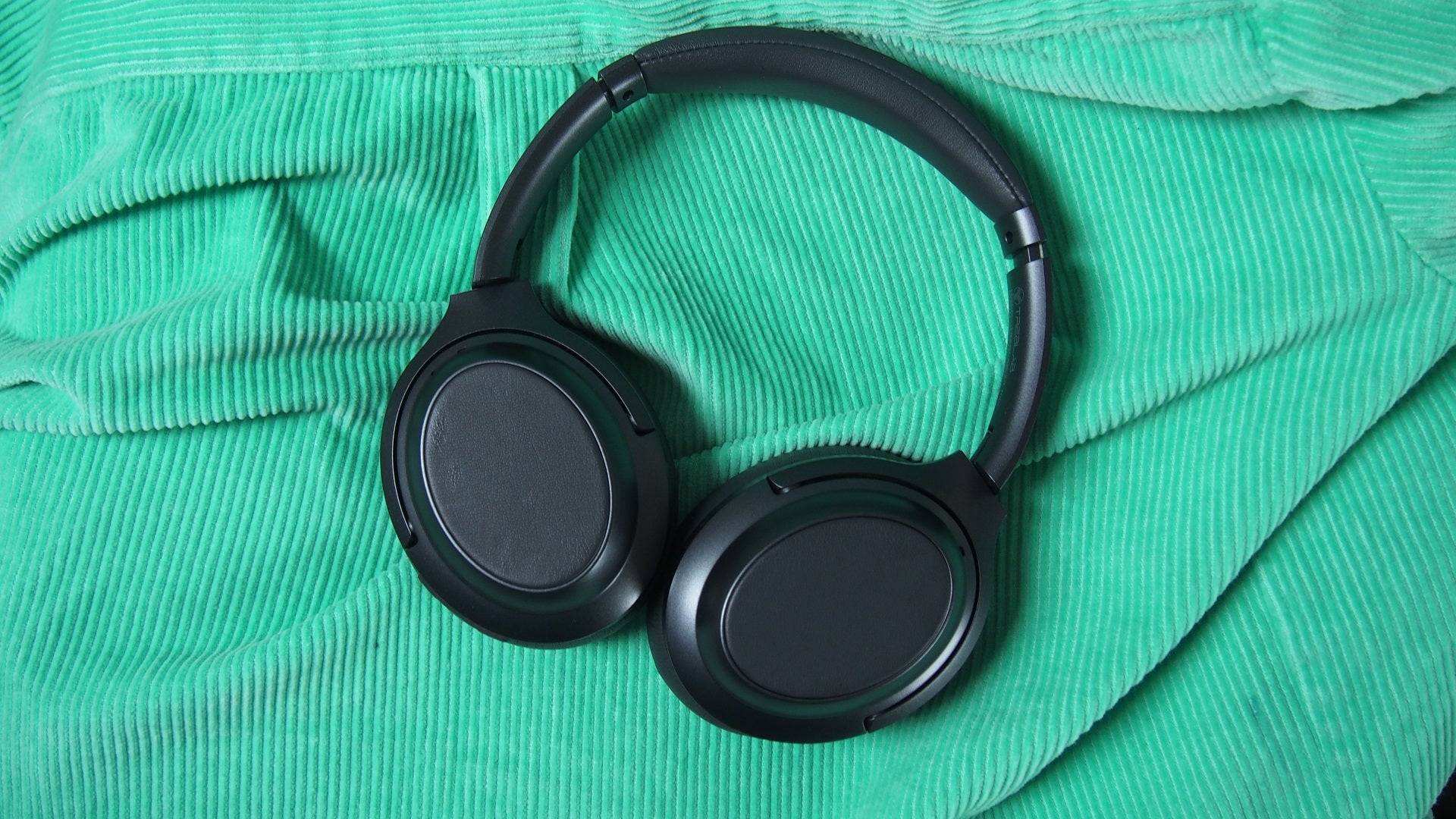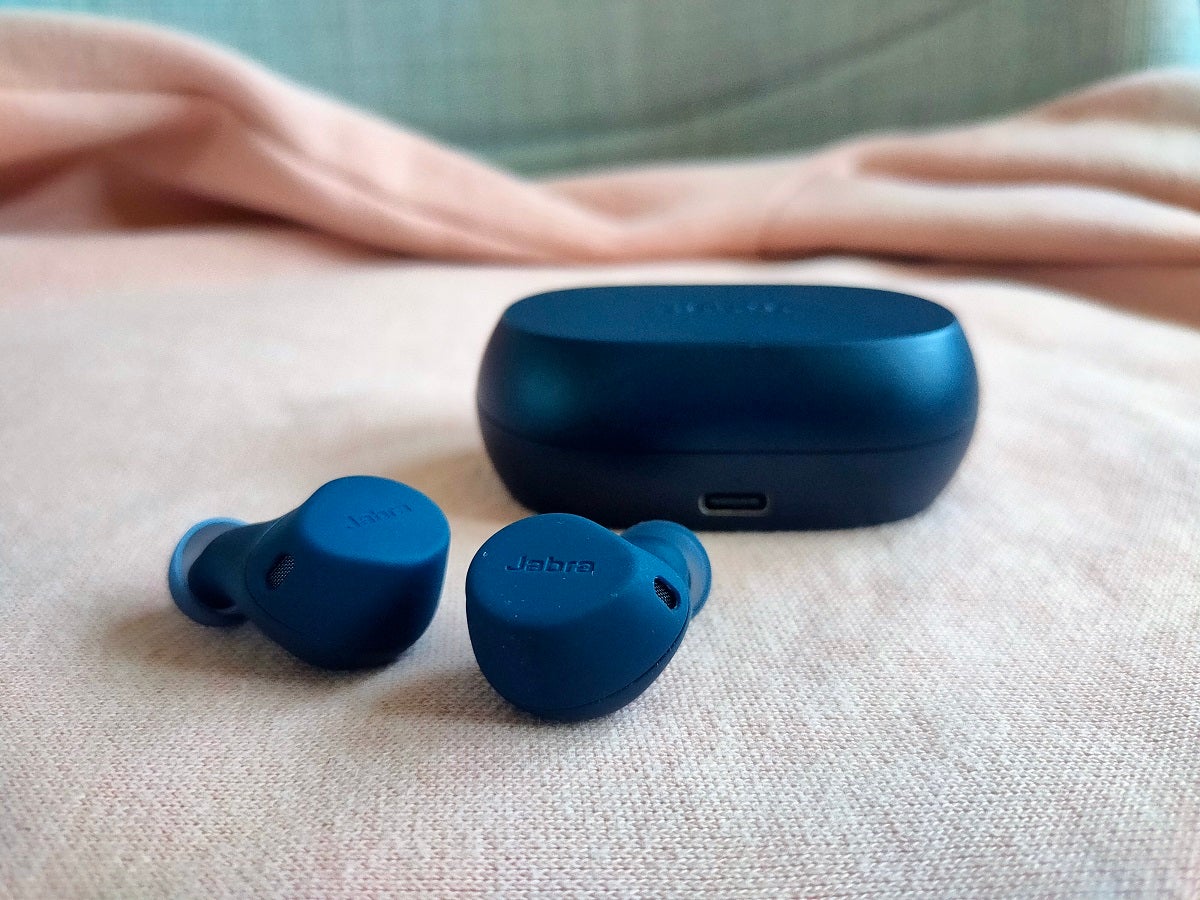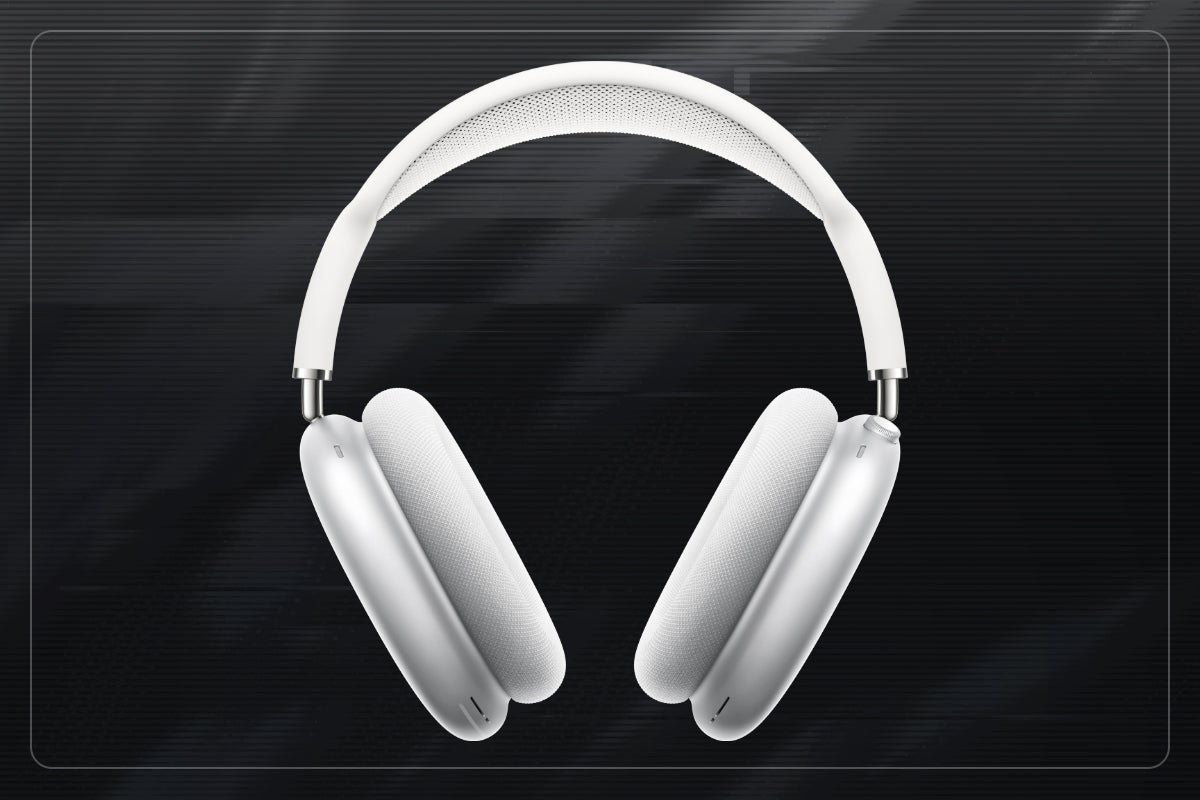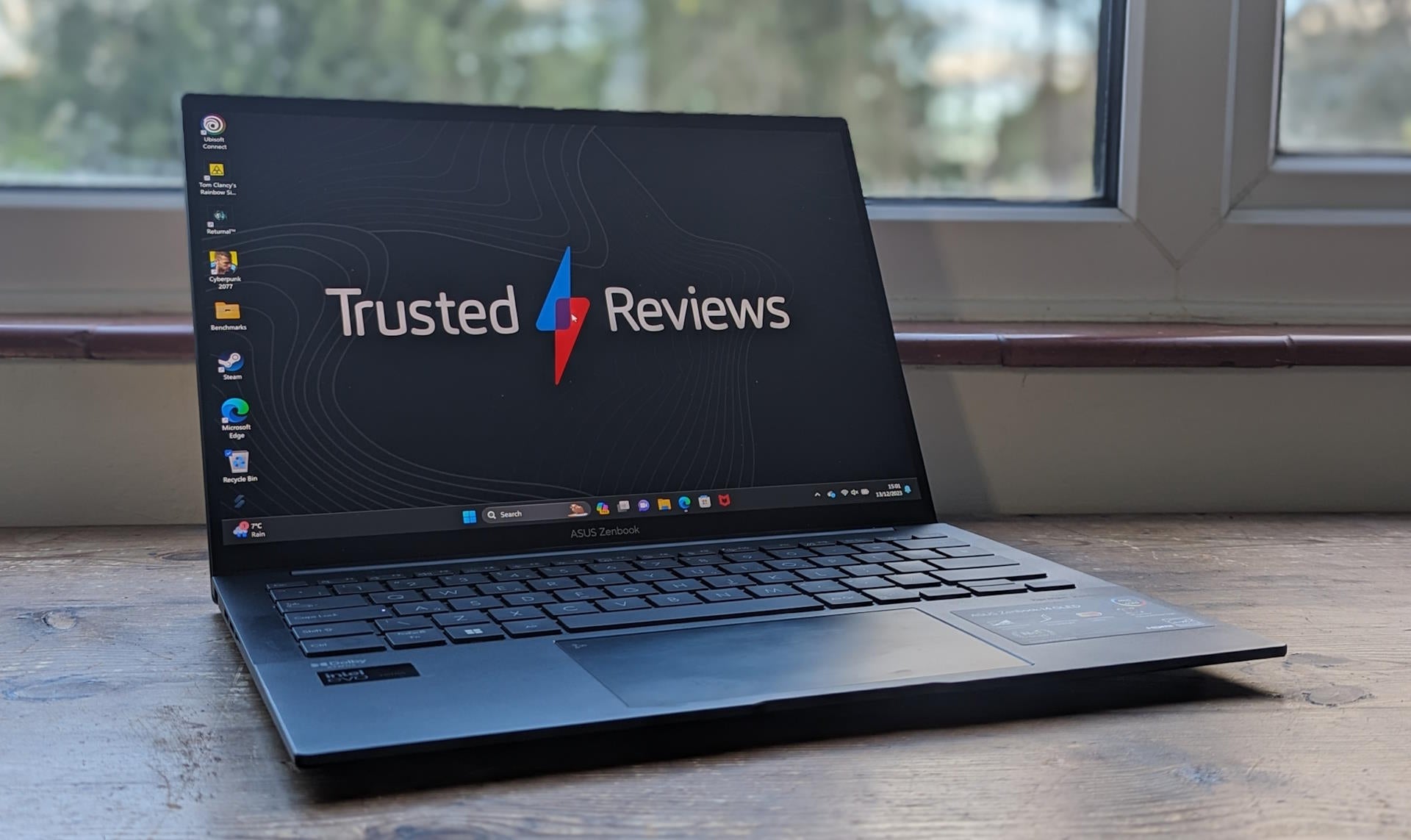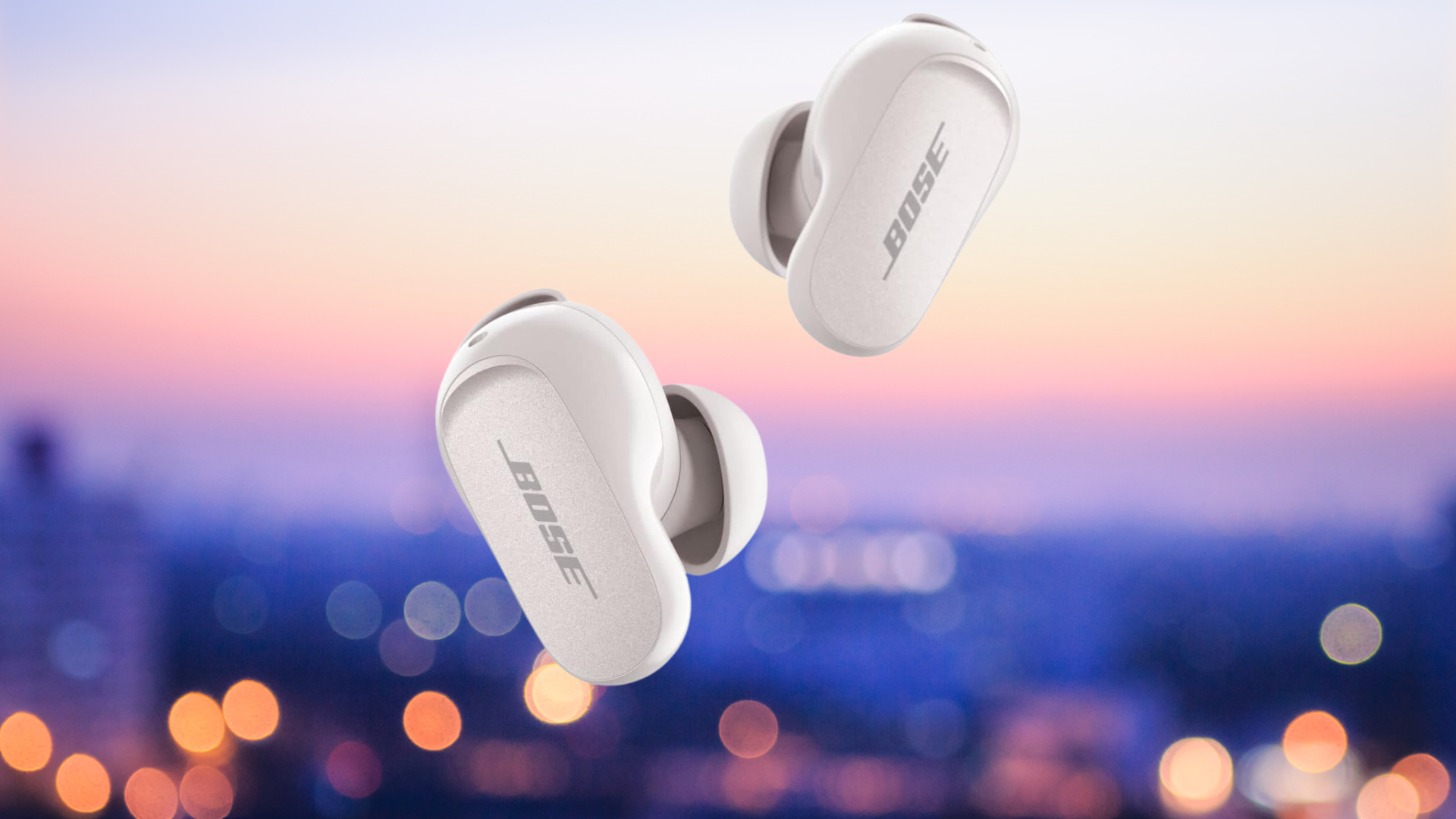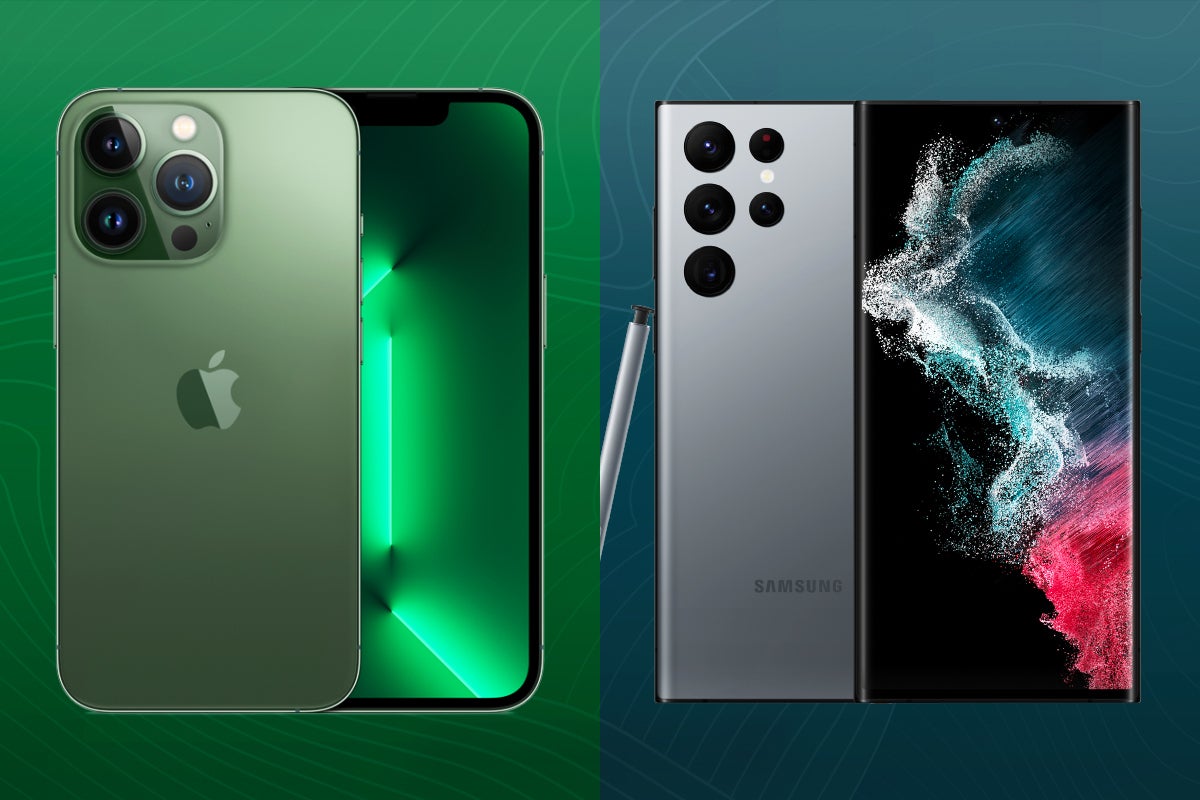Best Running Headphones 2024: Run to your favourite tracks
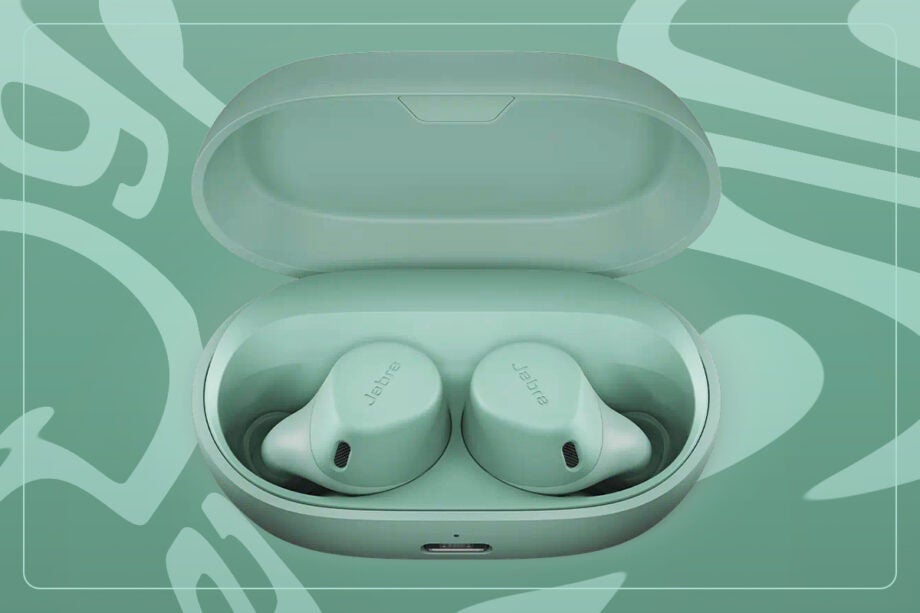
We’ve tested several of the best running and gym headphones to help find a pair that suits your workout regime.
There are many types of headphones to choose from, from over-ear, on-ear and true wireless. To help make it easier for you to buy a new pair, we put the best running headphones through their paces, taking them on runs, using them in the gym and listening to how good they sound.
We’ll also test these features such as noise-cancellation and transparency modes to determine how effective they are, and we’ll take a look at their durability and water resistance ratings, comparing to other similarly priced efforts to give you a better sense of what they’re good at and what they’re less good at.
We always on the prowl for more to add more of the best running headphones to this list. If a pair of the best running headphones isn’t what you’re looking, we do have several lists to help find a pair of headphones you might like.
Have a look at our best headphones, best wireless headphones, best wireless earbuds and best noise-cancelling headphones pages, to help knuckle down and find a new pair of headphones.
Best running headphones at a glance
- Best affordable true wireless for workouts: Back Bay Tempo 30 – check price
- Best true wireless for running: Jaybird Vista 2 – check price
- Best wireless fit: Cleer Arc II Sport – check price
- Best budget wired: Avantree E171 – check price
- Best workout on-ears: Adidas RPT-02 SOL – check price
- Best for runners: Adidas FWD-02 Sport – check price
- Best bone conduction headphones: Shokz OpenRun Pro – check price
- Best cheap open-ear headphones: Sivga S01 – check price
How we test
The best test of a pair of running headphones is, of course, running.
Our reviewers have amassed marathons’ worth of miles, pounding the park surfaces and hitting the treadmill to put these running headphones through their paces.
We make sure they’re not going to fall out of your ears, and that they can survive sweaty conditions without ending up in a sad heap (even that’s exactly what we do sometimes).
We’re also conscious you might want to use your running headphones for other exercise, such as the gym. We wear them under different scenarios, from an explosive Olympic weightlifting session to a spin class, and we also test running headphones away from the track or gym to see how they cope with regular listening.
We also take into account factors such as how securely they fit, their durability, sound quality and battery life.
- Inexpensive
- Energetic, rich sound
- Good fit and seal
- Long battery life
- Appear to be restricted to SBC playback
- Bass can overwhelm
- Excellent, gym-ready fit and seal
- Solid audio quality for a sports set
- Reliable battery life
- Rugged, sweatproof design
- ANC isn’t best in class
- Comfortable enough to wear
- Secure fit
- Better than expected audio performance
- Solid battery life
- Spatial awareness at all times
- Poor noise isolation
- App features feel rather redundant
- Expensive
- Inexpensive asking price
- Secure fit
- Good comfort
- Easy to use
- Audio profile skews towards bass
- In-line controls not compatible with every device
- Rich, energetic audio
- Long, long battery life
- Eco-conscious and durable design with washable elements
- Original model offers a better-balanced sound
- Fairly expensive for workout headphones
- Some may find on-ear design uncomfortable
- Plenty of options for getting the right fit
- Comfy fit
- Rich, punchy and weighty bass
- Natural-sounding awareness mode
- Not particularly dynamic or subtle sounding
- Earbud can move about with energetic exercise
- IP resistance could be stronger
- Slim, light headphones to wear for exercise
- Quick charge technology
- Multipoint pairing
- Enhanced bass doesn’t deliver outside
- Proprietary charging cable
- Different waterproof rating to OpenRun
- Balanced and enjoyable sound
- Secure and comfortable fit
- Charging status display in charging case
- Not the smallest
- Can’t customise controls
- Battery performance at louder volumes
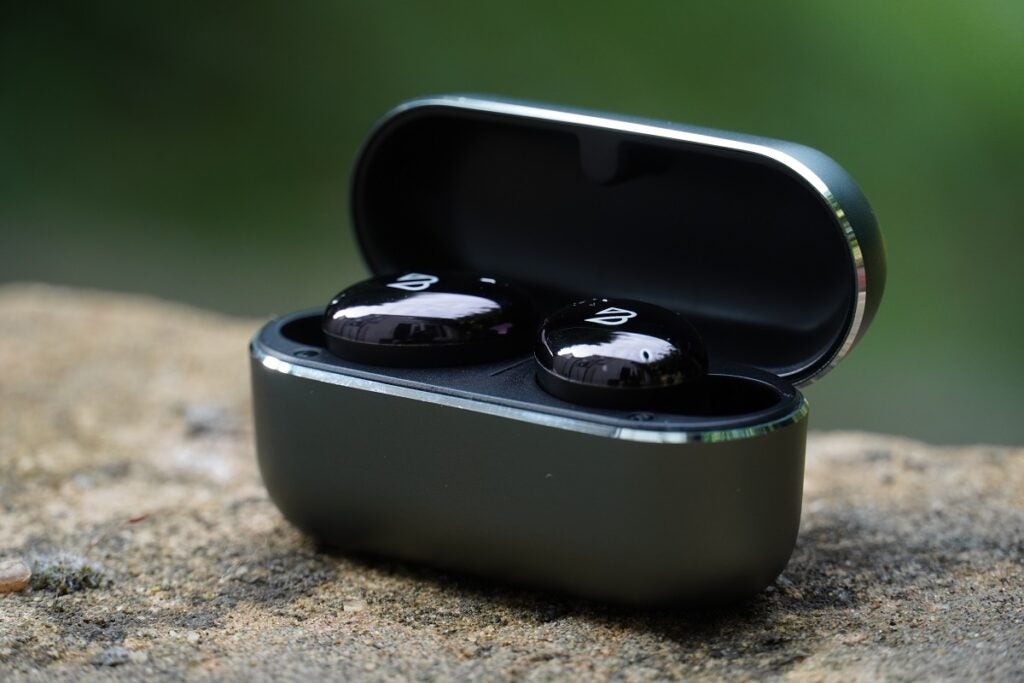
Back Bay Tempo 30
Best affordable sports true wireless
Pros
- Inexpensive
- Energetic, rich sound
- Good fit and seal
- Long battery life
Cons
- Appear to be restricted to SBC playback
- Bass can overwhelm
The Back Bay Tempo 30 are true wireless made for the sports fanatics among us, featuring a tough IPX7 water resistance that makes these buds fully sweatproof and waterproof. You won’t be able to take them swimming, but on solid ground Tempo 30 are protected against rainy weather.
We found the Tempo 30’s battery life of 32 hours in total to be excellent, especially in the $39.99 / £29 price bracket. That’s double the endurance of the more expensive Bose Sport Earbuds, although don’t expect fast charging or wireless charging support at this low price.
We liked the design of the Tempo 30 with its attractive, marble-like, glossy finish that’s a step up on the likes of the Jlab Go Air Sport. The charging case is pocketable, though over use we found it susceptible to scratches and scuff marks. We found the to be snug when using the earphones, and they didn’t fall out once, offering excellent noise isolation that’s as good as some running headphones with noise cancellation.
Several ear-tips are provided to keep the earphones tucked in, and they also affect how the Tempo 30 sound, adding or reducing bass. The default ear-tip produced a crisp and sharp tone that didn’t offer much bass. The ear-tip we settled on offered more weight, turning its strained performance into a more energetic one with a stronger bass output. The soundstage is wide, and while the definition of instruments is not be as good as more expensive buds, the overall sound quality makes the Tempo 30 a steal for the price.
Reviewer: Kob Monney
Full Review: Back Bay Tempo 30
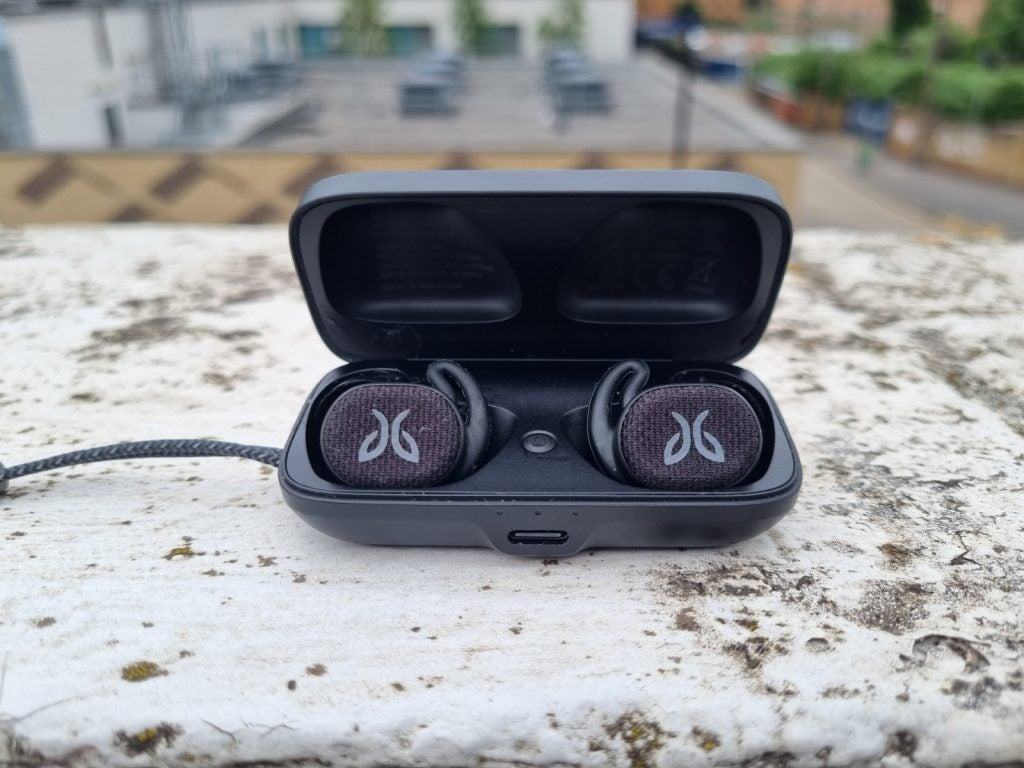
Jaybird Vista 2
Best sports true wireless
Pros
- Excellent, gym-ready fit and seal
- Solid audio quality for a sports set
- Reliable battery life
- Rugged, sweatproof design
Cons
- ANC isn’t best in class
Traditionally, running headphones haven’t always excelled at audio quality, and the Jaybird Vista 2 offer a more detailed and dynamic performance than their predecessors, alongside a deeper bass with more extension. We found the top end to be sparkly in nature, which sounded excellent during testing.
The Vista 2 are the first set of Jaybird earbuds to feature noise cancellation, a feature not necessarily found on many true wireless earphones. While we didn’t feel the ANC were best in class compared to premium efforts from Bose and Sony, they did a good job of blocking out background noise, although when faced wind noise or the sound of children in a nearby park they weren’t as strong. We found the ambient mode here to work well, although it did pick up some distracting wind noise.
There’s support for wireless charging, and the battery life is decent with 24 hours in total (ANC off) that’s similar to the Adidas FWD-02. We did find during our time that there were connectivity issues that required a factory reset for the earphones. It did only happen a few times and might have been specific to our sample, but its something to be aware of.
The design is similar to the original Vista with a few aesthetic tweaks to the case (rounded edges) and a fabric finish over the physical buttons. The fit and seal we found to be secure, and the Jaybird come with an array of ear- and wing-tip options to find the best fit. Jaybird has also upped the dust and water resistance rating from the original, pushing the earphones to IP68 with the case holding an IP54 rating from the original’s IPX7. That offers more confidence than these wireless earbuds can take on tougher assignments when you’re exercising.
Reviewer: Alastair Stevenson
Full Review: Jaybird Vista 2
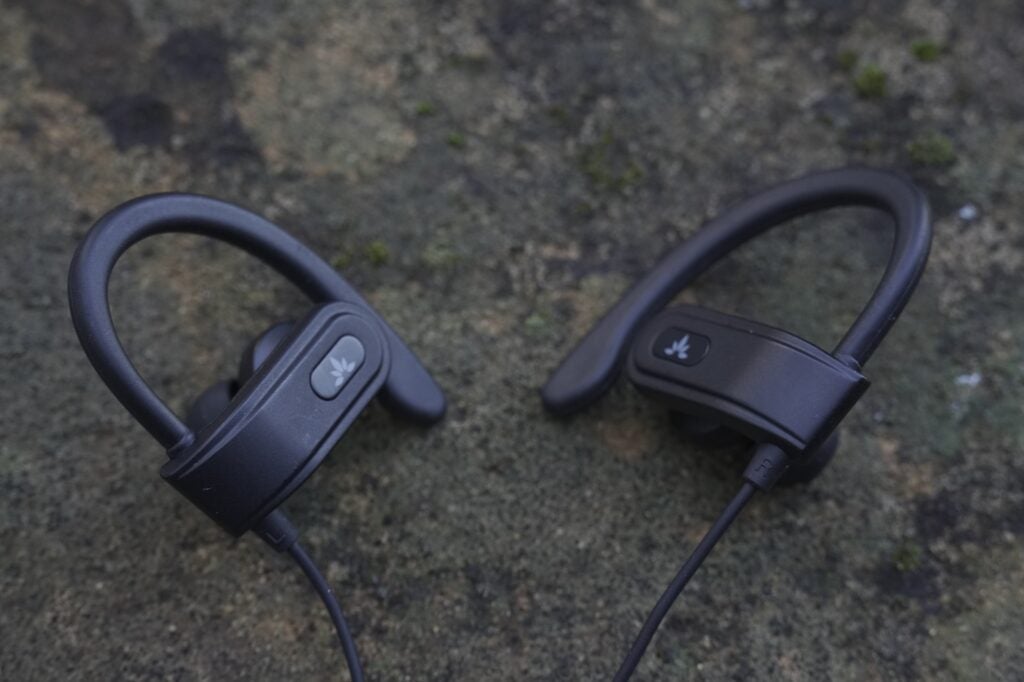
Avantree E171
Best budget wired
Pros
- Inexpensive asking price
- Secure fit
- Good comfort
- Easy to use
Cons
- Audio profile skews towards bass
- In-line controls not compatible with every device
Good audio quality shouldn’t need to cost the earth, and the Avantree E171 are a testament to that. With a low asking price of just £14.99, they are some of the cheapest wired earbuds you can find and could be the perfect pick for anyone who’s just getting into running and doesn’t want to invest in a premium pair of Adidas RPT-02 SOL or OpenRun Pro right off the bat.
We found them easy to wear and position, with no incidents of them coming loose or falling out during workout sessions. These headphones pack an IPX7 water rating, meaning that they can be submerged in water up to 1m deep for thirty minutes. That type of protection makes them more than serviceable for any workouts in the rain.
These are wired headphones and connect via a 3.5mm headphone jack. The cable comes with an in-line mic/control that allows you to adjust the volume and speak into the microphone. It’s worth noting that these controls are not compatible across the board – with no support for the built-in volume control on PCs and laptops – so you may need to test your devices to ensure that they are supported.
We found these headphones to offer a well-balanced audio experience, although they are clearly tuned towards bass rather than higher frequencies. Kept at a lower volume, the bass was better balanced with a powerful low end in songs like Fleetwood Mac’s The Chain. The soundstage held a lot of presence, however, with natural midranges throughout.
While you can find more premium running headphones on this very list, you won’t find anything as affordable as the Avantree E171. These could be the perfect starting point for runners hoping to indulge their musical side while working out and arguably a steal for under £15.
Reviewer: Kob Monney
Full Review: Avantree E171
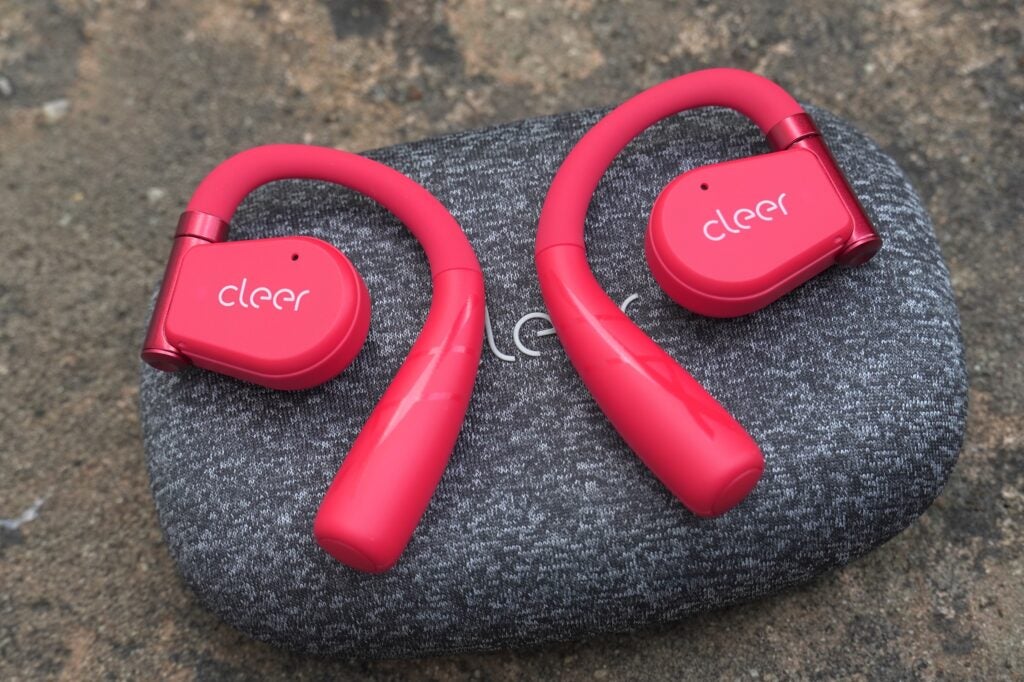
Cleer Arc II Sport
Best wireless fit
Pros
- Comfortable enough to wear
- Secure fit
- Better than expected audio performance
- Solid battery life
- Spatial awareness at all times
Cons
- Poor noise isolation
- App features feel rather redundant
- Expensive
The Cleer Arc II Sport are a well-conceived and executed pair of open-ear headphones that exceeded our expectations. They sport an over-ear hook design wedged between your ear and head, with no earbud or eartip entering your ear. This makes them ideal for anyone who doesn’t want to be completely cut off from their surroundings; whether you’re on a run and want to listen out for traffic and pedestrians or don’t want to miss your train announcement at the station, you will have a better awareness than with a traditional pair of earbuds.
Each earbud weighs just 14g each and we found that they were solid in the comfort department. The tap controls were alert and responsive, even during runs, and were easier to use than expected. They are also rated IPX5, which means that they can handle water, rain and sweat without issue. They cannot be directly immersed in water however so you shouldn’t try and use them in the shower or during any water activities.
The Arc II Sport produce a sizeable amount of bass with genuine depth and punch that adds a lot of excitement to the music. Bone conduction headphones are known for missing out on bass, but these bring a pleasing amount of weight to low frequencies. There are some smaller issues here and there, but what the Cleer can do is very commendable for open-ear headphones.
Overall, if you’re interested in trying out bone or air-conduction headphones, then the Cleer Arc II Sport are a great place to start. Audio execution is done very well and the secure fit means that they won’t come flying off during your next run. If you’re happy with the admittedly high $189/£199 price tag then these are a very easy recommendation for most runners.
Reviewer: Kob Monney
Full Review: Cleer Arc II Sport
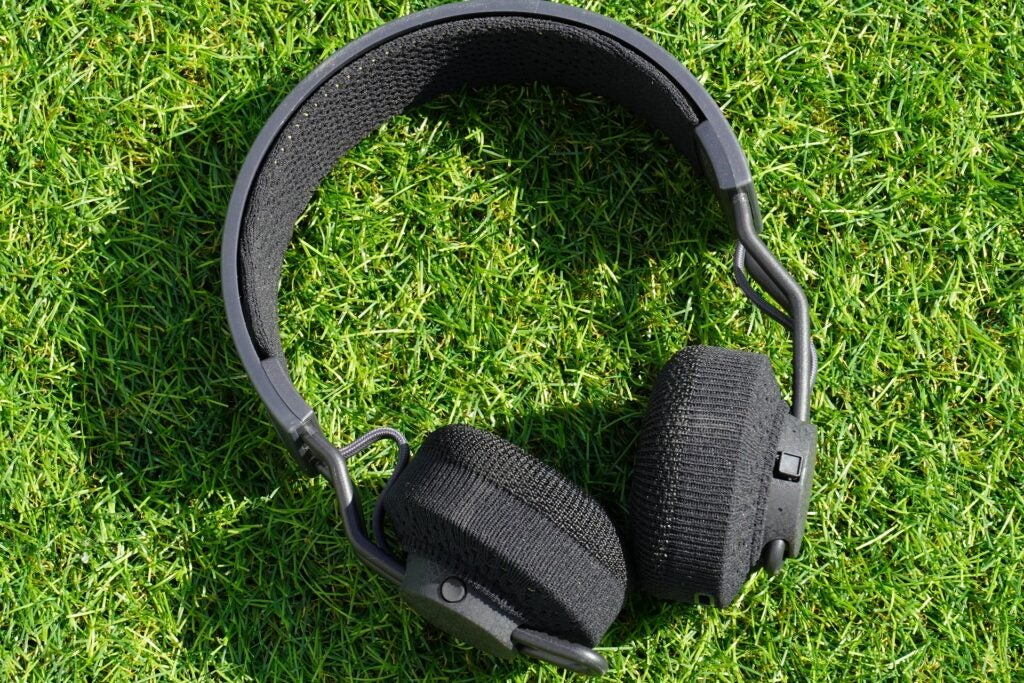
Adidas RPT-02 SOL
Best workout on-ear headphones
Pros
- Rich, energetic audio
- Long, long battery life
- Eco-conscious and durable design with washable elements
Cons
- Original model offers a better-balanced sound
- Fairly expensive for workout headphones
- Some may find on-ear design uncomfortable
It’s not often in the headphone market you get something different from the norm, but in the Adidas RPT-02 SOL, you get exactly that.
The RPT-02 SOL is part of a new breed of headphones like the Urbanista Los Angeles and Phoenix, that integrate a solar charging panel into its design. This helps to charge the headphones both when in use or simply turned on, absorbing sun and ambient light to give it a power boost.
We found that while solar panel doesn’t provide enough charge to add to the battery when in use, it is enough to reduce the battery discharge. Over the course of six weeks, using the headphones in the gym and for runs for several hours, the percentage drop in battery was only 8%. Overall battery life is around 80 hours, so these headphones have plenty left in the tank even if they’re not being topped off by the solar panel.
The design continues the eco-conscious outlook of the original RPT-01 with machine-washable fabrics and the use of recycled plastic for its construction. For a pair of on-ears, they’re stable and comfortable enough to wear, pinching on the ears only occurring when deep into sessions, and we found them to be lightweight at 256g to not be uncomfortable when worn. With an IPX4 rating, they can dispel splashes of water and sweat easily enough.
We found the sound quality to differ quite significantly from the original model. Where the RPT-01 was clear and crisp, the sequel is more rich and bombastic, especially with bass frequencies. It describes tracks with more energy, but loses out on the subtlety of the (still available) original pair. Nevertheless, we found them to be a fun, energetic-sounding pair of headphones that complement high-energy workouts.
One thing to note is that they are more expensive than the original were at £199 / $199. If you are looking for a pair of on-ears for sports and workouts, it’s worth checking out the cheaper RPT-01.
Reviewer: Kob Monney
Full Review: Adidas RPT-02 SOL

Adidas FWD-02 Sport
Best sports true wireless for runners
Pros
- Plenty of options for getting the right fit
- Comfy fit
- Rich, punchy and weighty bass
- Natural-sounding awareness mode
Cons
- Not particularly dynamic or subtle sounding
- Earbud can move about with energetic exercise
- IP resistance could be stronger
Adidas is best known for its sportswear than its audio devices, but they have dipped their toes into the world of audio before, and the Adidas FWD-02 Sport are our favourite of their true wireless efforts so far.
They have a different design to the Z.N.E 01 with the FWD-02 opting for a circular shape that fits well in the ear, a fit that’s complemented by a strong selection of winged ear tips to help keep them secure. Our only issue was that the FWD-02 still moved about when running, which meant we had to regularly nudge them back in. Your mileage (quite literally) may vary with different ear-tip sizes.
The IP rating is IPX5, which makes the FWD-02 resistant to low pressure and sustained jets of water. This is fine, though we half-expected a tougher rating given these buds were designed in consultation with the Adidas Runners group. There is no ANC with the FWD-02s like you’d find with the Jaybird Vista 2, with their design aiming to reduce external noise, which we found to be good enough.
Battery life matches the Z.N.E 01 ANC with 25 hours in total, which is absolutely fine for several gym/running sessions. The Adidas headphones offer the ability to check on those battery levels, as well as customise touch controls, and EQ settings to change the sound.
These headphones are made by Zound Industries which also works on Marshall and Urbanears headphones, and they’ve produced decent-sounding headphones with the FWD-02. They sound similar to the Z.N.E. 01 ANC filled with lots of energy, a weighty low end and smooth delivery that works well for high-intensity workouts. The soundstage has some width to it, and while there aren’t the detailed or most dynamic-sounding headphones, the bass is punchy and rich.
Reviewer: Kob Monney
Full Review: Adidas FWD-02
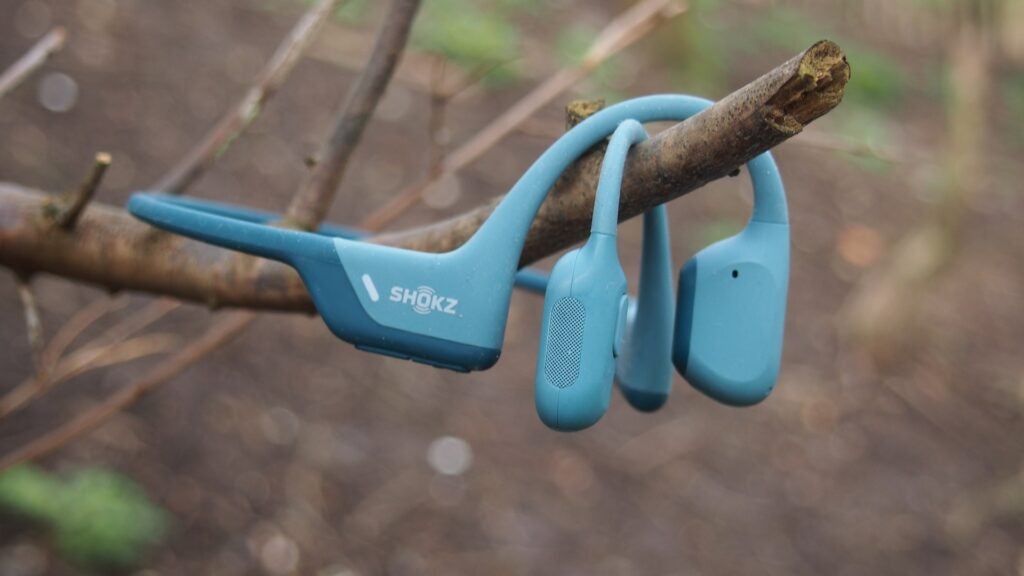
Shokz OpenRun Pro
Best bone conduction headphones
Pros
- Slim, light headphones to wear for exercise
- Quick charge technology
- Multipoint pairing
Cons
- Enhanced bass doesn’t deliver outside
- Proprietary charging cable
- Different waterproof rating to OpenRun
The brand formerly known as Aftershokz was rebranded as Shokz, but that didn’t manifest any different change in approach. When it comes to bone-conduction headphones, Shokz is probably the most known entity out there, and the OpenRun Pro model is one of the better proponents of the technology.
Bone conduction works by producing vibrations through your cheek/jawbone to your ear. This means the design is an open-ear model, which also allows you to hear what’s around you. This is especially useful if you’re using them in an outdoor environment.
The OpenRun Pro are lightweight at 29g and we found them comfortable to wear. Despite the lightweight frame, our reviewer found they stayed put during exercises, so there’s no fear that they’d be dislodged when running. A rating of IP55 means the OpenRun Pro can resist the likes of sweat, water and dust, though in fact, this is a weaker IP rating than older Shokz headphones.
The Shokz promise 10 hours of battery life, which is up from the eight hours of the original OpenRun. Using them with the volume set pretty much at its maximum, we managed to get five hours of use, though Shokz was testing at 75% so if the volume is lowered you’re likely to eke out more battery life. Multipoint Bluetooth is supported, so you can switch between two devices simultaneously. There’s no built-in MP3 player that you’ll find on the Naenka Runner Pro model, as this only supports audio over Bluetooth.
When it comes to audio performance, the OpenRun Pro promise a sound that offers enhanced bass and premium sound quality. We found it didn’t quite live up to those expectations, especially when it comes to bass, which has been a shortcoming with most bone-conduction headphones. If you do want a bassier, bigger sound, however, the Philips TAA6606 is an alternative.
There are two modes to choose from in Standard and Vocal, and the latter presents a greater focus on clarity, while the Standard mode offers a punchier sound than previous Shokz headphones. These aren’t as good as a true wireless pair such as the Adidas FWD-02 in terms of audio, but they are one of the best bone-conduction headphones.
If you find the OpenRun Pro too expensive, there is the option of the cheaper OpenRun that’s still available. There’s also the OpenRun Mini, which is a version for smaller heads that costs the same as the ‘Pro’ model.
Reviewer: Mike Sawh
Full Review: Shokz OpenRun Pro

Sivga S01
Best cheap open-ear headphones
Pros
- Balanced and enjoyable sound
- Secure and comfortable fit
- Charging status display in charging case
Cons
- Not the smallest
- Can’t customise controls
- Battery performance at louder volumes
It almost goes without saying that if you want to listen to your favourite songs during a run in the safest way possible then open-ear or bone conduction headphones are a must. These designs keep your ear canals open, making it a great deal easier to stay in tune with what’s happening around you. The only problem is that the high-end models don’t come cheap, but the Sivga S01 are here to set the record straight.
Going against the grain, these open-ear headphones are surprisingly affordable with a price tag of just £69.90/$69.90, making them ideal for any runners tied to a strict budget. What’s even more surprising than the price tag is that, in spite of their affordability, the Sivga S01 still pack a ton of great features.
For starters, the headphones boast IPX5 water and sweat resistance so you won’t have to worry about getting caught in the rain or taking the S01 on a particularly intensive run. You can expect a battery life of up to nine hours on a single charge which is more than enough to get you through a marathon.
When it comes to topping them up, the S01 come with a compact charging case that not only has wired USB-C charging but also wireless charging compatibility (something of a rarity at this price range).
The design itself is also incredibly thoughtful for the needs of runners, as the use of physical buttons to control volume and playback is much easier to contend with when your hands are sweaty, and the use of ear-hooks allows the Sivga S01 to comfortably sit in place without worry that they might fall.
While the Sivga S01 don’t exactly beat out the competition on sound quality – in-ear and over-ear options will always come out on top – they still manage to outdo themselves. Audio is well-balanced so nothing crucial gets lost in the mix, and there’s a fair amount of bass too.
We also considered…
We’ve reviewed
See all reviewsFAQs
We’ve not tested as many fitness-focussed over-ears but the UA Project Rock Training headphones are a good shout, especially for the comfort they offer.




